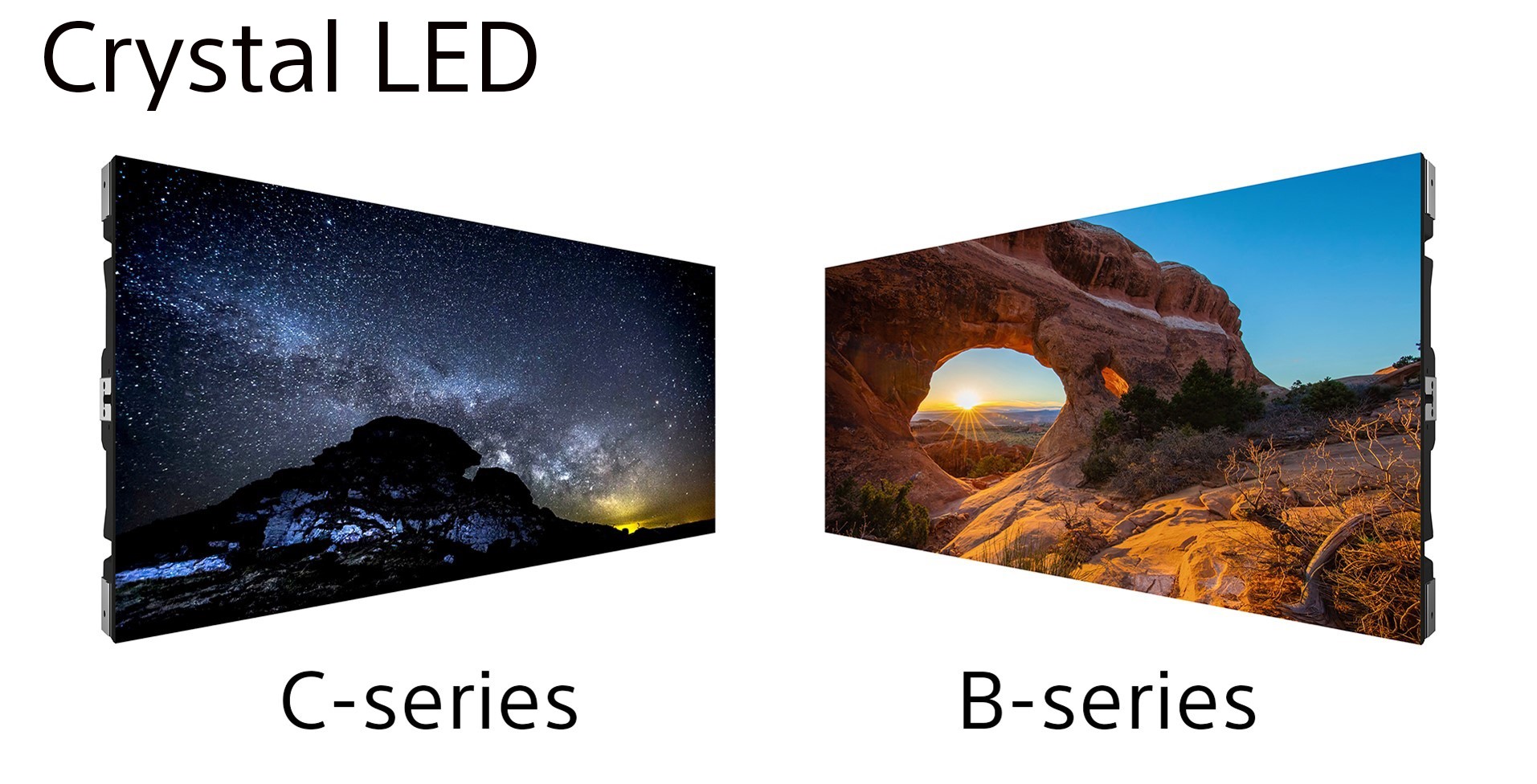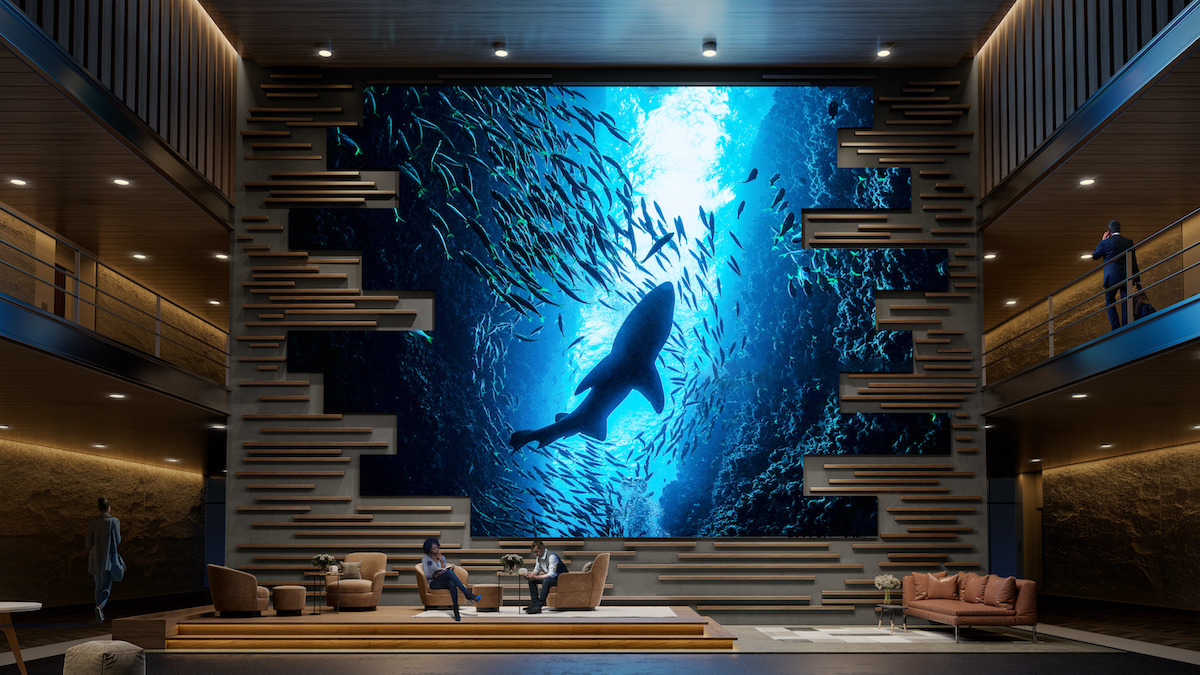
Sony Launches Two Next-Gen Crystal LED Video Wall Products
January 6, 2021 by Dave Haynes
Sony Electronics has announced the next generation of its Crystal LED video wall display series – the technology that gained all the attention when Sony first launched Crystal LED.
The original Crystal LED was the industry’s first look at large format microLED video walls, and the new versions, from what I am hearing, are microLED-ish – teeny-tiny LEDs, but maybe not microLED by pure technical definition.
The reason: lowered upfront costs and total cost of ownership, and perhaps a recognition that super-teeny light chips aren’t the only factor in delivering premium visuals on a big display canvas. Contrast, color gamut and image processing are big keys.
The new product borrows on the R&D and real-world learning coming out of Sony’s pioneering large-format microLED work. The two new products focus on high contrast and high brightness, with pixel pitches set at 1.26mm and 1.58mm. Those definitely fit within the definition of fine or narrow pitch, but there are numerous direct view LED manufacturers marketing conventional surface-mounted LED displays with pixel pitches finer than 1mm.
What’s grown evident with microLED products – including ones called microLED even if they aren’t micro in pure technical terms – is that the amount of deep black visible on the substrate between the light chips is arguably more important to visual quality than the physical size of the LED light. More, deep black means better contrast, which results in better visuals.
The existing Sony Crystal LED boasts how 99% of the visible surface of its modules is black. If you are not using super-teeny microLED light chips, the way to still deliver a high percentage of black when the light pixels are bigger is to space those light pixels further apart – hence the 1.26mm and 1.58mm pitch.
If you looked at, let’s say, a conventional 0.9mm pixel pitch LED display made using surface-mounted (SMD) LED modules, you’d see a very crisp image but the LED light “packages” are set so tight together that the substrate is largely hidden. So the blacks and contrast are not, at least typically, as good.
The new Sony Crystal LEDs come in two versions, both at the two pixel pitches. The C series is about high contrast and the B series is about brightness, with 1,800 nits vs 1,000 with the existing product.
Says Sony in announcing the products today:
Both new displays are available in two pixel pitch sizes (P1.26mm and P1.58mm) to suit different installation needs and expand the line-up of Sony’s Crystal LED for various applications including corporate showrooms, lobbies and productions. They combine impressive image quality, flexibility and scalability in installation, with lower total cost of ownership, and leverage Sony’s expertise in providing dynamic visual experiences that faithfully and accurately showcase content as the creator intended.
Both series are equipped with the “X1 for Crystal LED”, high-performance image quality processor. It fully incorporates the LED control technology developed for Sony’s pioneering Crystal LED and the signal processing technology praised in Sony’s BRAVIA TV series. Additionally, the displays enable image accuracy inspired by the industry leading master monitors, providing highly realistic large-scale imagery that maintains image integrity close-up and at a distance.
The new displays provide enhanced content that is upscaled while maintaining high-resolution (“Reality Creation”), smooth and artifact-free pictures without motion blur (“Motionflow”) and showcase impressive gradation expression (“22bit Super Bit Mapping”). Highlights also include a wide viewing angle and wide color gamut, as well as a various input signals, including HDR, HFR (120fps) and 3D.
The displays are designed to be flexible, long-lasting and easy-to-install. Each display is comprised of modular, seamless and bezel-free tiles that can scale to accommodate a range of sizes, layouts and resolutions. Due to the display’s light weight and streamlined design, it can be installed in various configurations including wall-mounted or in a curved arrangement.
“Sony has been creating unforgettable images and engaging experiences that empower and stimulate creators’ curiosity for over 60 years,” says Theresa Alesso, Pro Division President, Sony Electronics. “As we continually strive to get closer to our customers and solve their challenges, we’ve implemented the features and benefits that they value most in a direct view microLED display. The ease of installation, accessibility, flexibility and a lower total cost of ownership can further expand spatial expression– all with the outstanding picture quality proven by the original Crystal LED.”
The Crystal LED C-series provides high contrast of 1,000,000:1. This series features a deep black coating optimized for a range of applications including use in corporate showrooms, lobbies, and customer experience centers, among others.
The Crystal LED B-series offers high brightness (1,800 cd/m2 [1]) ideal for bright environments while still showcasing astonishingly realistic images with a wide color gamut. This series has an anti-reflection coating with a matte finish that is especially ideal for creators, designers and production applications including virtual sets and studio backdrops. B-series was developed in collaboration with Sony Pictures Entertainment to reflect the creator’s needs.
Due to lower power consumption and convenient, user-friendly front accessibility, the new displays can provide a reduced total cost of ownership including maintenance, after purchase. In addition, the Crystal LED C- and B-series are both fanless, ensuring quiet operation and feature a 100-240V AC power supply, providing customers with enhanced usability.
Crystal LED C-series and B-series are planned to be available come summer, but are being announced now to coincide with CES 2021 (which this year is virtual).
Sony introduced the digital signage and pro AV ecosystems to microLED, and had people like me seeing it for the first time and asking Sony people: “What is that???”
The microLED product has been selling, and I have seen it in places like Apple stores. It is also going into the homes of some super-rich people who would barely blink when told their new TV will cost $1M+.

MicroLED is, by circumstance, very expensive technology right now – owing to material and manufacturing costs. There are millions of light chips as material cost, and current manufacturing methods and technologies are not at a point where mass production for microLED is cost-effective and near error-free.
That will come, given the amount of advanced R&D happening. Lots of companies (including STRATACACHE) are investing in microLED with the idea that costs will drop dramatically and that microLED has a big future role in large-format displays.
But the pure technical aspects of large format LED – whether it is micro or mini or SMD or whatever – matters less to specifiers and buyers than what the screen looks like, how it performs and what it costs. So if Sony can leverage the premium reputation of Crystal LED to sell a product that looks great but is more cost-competitive, that makes sense.
Samsung (The Wall) and LG (Magnit) have both gone down what appears to be a similar path, marketing quasi-microLED video wall products that combine tiny light chips with a lot of surrounding black.
Sony is also putting an emphasis in this new product on the underpinnings of a great display, such as image processing and upscaling.
One little nugget in the release is that the B series has an anti-reflection coating with a matte finish. That’s an advance over the existing Crystal LED, which has a glossy coating and picks up a lot of reflection in brightly-lit spaces like retail.
Lord knows when any of us will see one of these units in action at a trade show or elsewhere. While software can effectively be demo’d and sold virtually, premium display hardware is something that really needs to be seen to be appreciated, and the significant investment validated.
Maybe Sony will send me a sample??? I can supply wall measurements. ;-]
Good launch video here …



Leave a comment